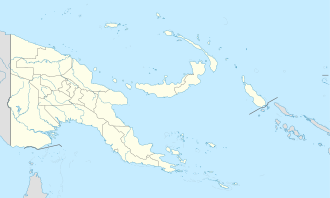History
In May 1944, the US Navy's 7th Amphibious Force requested a base at Alexishafen to provide repair and logistical support for the many boats operating off the north shores of New Guinea. Alexishafen and Madang were liberated on April 26, 1944, by the Australian Army 30th Battalion in the Battle of Madang. Alexishafen's Bostrem Bay offered excellent fleet anchorage. The US Navy began using Bostrem Bay on April 27, 1944, when a destroyer Anchored at Alexishafen. Construction started on June 13, 1944, with the arrival of 200 troops with the US Navy's Seabee 91st Construction Battalion. The troops and supplies had arrived from Naval Base Finschhafen and Naval Base Milne Bay. Base facilities were built on Alexishafen south peninsula, Megas Island and Ulimal Island. All construction was completed on August 17, 1944. Australian had a base at Madang, including a capture runway, Madang Airfield. The Australians built a seaplane base in Madang Bay, used by the US Navy also. By November 1944 the Alexishafen base was too far behind the current Navy action and parts of the base were moved to more forward bases. On December 25, 1944, 80 troops from the 91st Construction Battalion packed up parts of the base to be shipped out to forward bases. The US Navy closed the base on January 28, 1945. The Alexishafen water-supply system was transferred to the Royal Australian Navy. [1] [3]
This page is based on this
Wikipedia article Text is available under the
CC BY-SA 4.0 license; additional terms may apply.
Images, videos and audio are available under their respective licenses.







